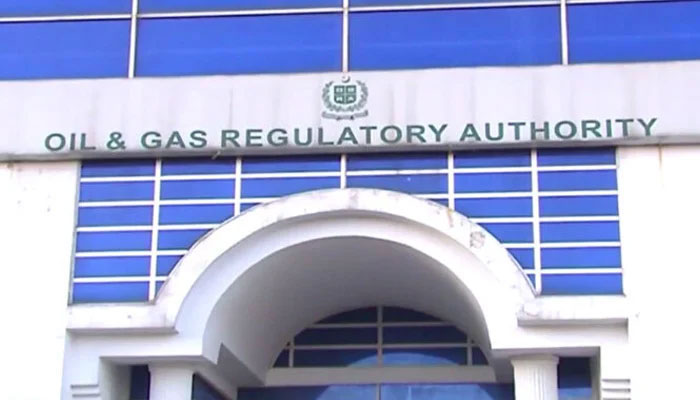OGRA raises RLNG prices up to 6.5pc for SSGC, SNGPL consumers
ISLAMABAD: The Oil and Gas Regulatory Authority (OGRA) has raised the prices of re-gasified liquefied natural gas (RLNG) for consumers of Sui Southern Gas Company (SSGC) and Sui Northern Gas Pipelines Limited (SNGPL) by over 6 percent effective May 1, 2024.
The price hike, announced on Friday, increased RLNG prices by $0.8559 per million British thermal units (mmBtu) or 6.5 percent for SSGC consumers and by $0.7978 per mmBtu or 6.16 percent for SNGPL consumers.
According to OGRA's notification, the new weighted average sale price for SNGPL consumers has been set at $13.744 per mmBtu, while SSGC consumers will be charged $14.0506 per mmBtu. In April 2024, the prices were $12.946 and $13.1947 per mmBtu for SNGPL and SSGC consumers, respectively. OGRA attributed the increase to higher supply charges.
Since September 2023, RLNG prices have fluctuated, with only two months recording price reductions. In September 2023, prices rose by 3.08 percent, followed by a 3.87 percent increase in October, a 1.2 percent increase in November, and a significant 10.1 percent increase in December.
Prices decreased by 7.8 percent in January 2024 and by 9 percent in February, before rising again by 2.57 percent in March and 1.06 percent in April.
The revised RLNG prices encompass various cost elements, including charges for LNG terminals, transmission losses, port charges, and margins for state-owned importers such as Pakistan State Oil (PSO) and Pakistan LNG Limited (PLL). These new prices are based on the 11 cargoes imported for the month, including 10 by PSO and one by PLL.
RLNG, being an imported product, is pegged to international oil prices. Consequently, an increase in international oil prices necessitates a corresponding price hike by OGRA. RLNG is a major contributor to the country's power generation. Therefore, an increase in RLNG prices elevates the cost of energy, subsequently raising the tariff for power consumers.
-
 Rachel McAdams Becomes Object Of Jokes At Hollywood Star Of Fame Event
Rachel McAdams Becomes Object Of Jokes At Hollywood Star Of Fame Event -
 South Korea's Ex-PM Han Duck-soo Jailed For 23 Years Over Martial Law Crises
South Korea's Ex-PM Han Duck-soo Jailed For 23 Years Over Martial Law Crises -
 Global Markets On Edge Over Greenland Dispute: Is US Economic Leadership At Risk?
Global Markets On Edge Over Greenland Dispute: Is US Economic Leadership At Risk? -
 King, Queen Visit Deadly Train Crash Site
King, Queen Visit Deadly Train Crash Site -
 Oxford Research Warns ChatGPT Reflects Western Worldviews
Oxford Research Warns ChatGPT Reflects Western Worldviews -
 UK Inflation Unexpectedly Rises To 3.4% In December, The First Increase In Five Months
UK Inflation Unexpectedly Rises To 3.4% In December, The First Increase In Five Months -
 Meghan Markle Set To Take Big Decision On Returning To UK For Invictus Games
Meghan Markle Set To Take Big Decision On Returning To UK For Invictus Games -
 Prince Harry To Leave Britain One Day Earlier Than Expected For THIS Reason
Prince Harry To Leave Britain One Day Earlier Than Expected For THIS Reason -
 The Way You Consume Sugar Could Be Affecting Your Health
The Way You Consume Sugar Could Be Affecting Your Health -
 Brooklyn Beckham Gets Backing From Vanessa Marcil Amid Feud With Parents
Brooklyn Beckham Gets Backing From Vanessa Marcil Amid Feud With Parents -
 OpenAI Uses AI To Detect Under 18 Users On ChatGPT
OpenAI Uses AI To Detect Under 18 Users On ChatGPT -
 Philippines To Lift Ban On Grok AI After Musk's Platform Commits To Fix Safety Concerns
Philippines To Lift Ban On Grok AI After Musk's Platform Commits To Fix Safety Concerns -
 Trump Vows ‘no Going Back’ On Greenland Ahead Of Davos Visit
Trump Vows ‘no Going Back’ On Greenland Ahead Of Davos Visit -
 Alexander Skarsgard Breaks Silence On Rumors He Is Bisexual
Alexander Skarsgard Breaks Silence On Rumors He Is Bisexual -
 King Charles Faces Rift With Prince William Over Prince Harry’s Invictus Games
King Charles Faces Rift With Prince William Over Prince Harry’s Invictus Games -
 Elon Musk’s Critique On ChatGPT Safety Draws Sharp Response From Sam Altman
Elon Musk’s Critique On ChatGPT Safety Draws Sharp Response From Sam Altman




